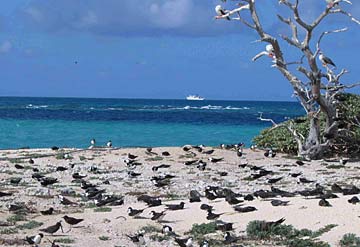"(The governor) has completely raised the bar. ... It is an extraordinary surprise and extraordinary day."
Stephanie Fried
Environmental Defense senior scientist

STAR-BULLETIN / AUGUST 2005
Black and white sooty terns, on the ground, and red-footed boobies, in a tree, are two species that nest on Tern Island.
|
|
Fishing banned in NW isles
New state rules create the nation's largest conservation area
By Tara Godvin
Associated Press
Fishing will be now banned and public access limited in the state waters surrounding the tiny islands and atolls of the Northwestern Hawaiian Islands, which stretch 1,200 miles across the Pacific Ocean.
Gov. Linda Lingle signed the new state rules yesterday creating the Northwestern Hawaiian Islands State Marine Refuge.
State waters extend three miles from the shores of the largely uninhabited area, which starts about 155 miles northwest of Kauai and is home to delicate coral reefs, scores of fish species and endangered Hawaiian monk seals and sea turtles.
The new state rules would continue to allow traditional native Hawaiian cultural practices in the area.
Peter Young, director of the state Department of Land and Natural Resources, said the state is asking the federal government to also ban fishing in a proposed National Marine Sanctuary extending 50 miles offshore, an announcement that drew applause and cheers from several environmentalists in the room.
"Because the broader, bigger message is, It's important for us to have a place in the world where we don't take something," Young said.
The federal waters include 132,000 square miles of ocean that were designated the Northwestern Hawaiian Islands Coral Reef Ecosystem Reserve in late 2000. The reserve is in the process of being designated a National Marine Sanctuary, which includes deciding upon regulations for the area.
Young said that if fishing and other types of harvesting, such as gathering of precious corals, are banned from all waters in the islands, the area would become the largest marine protected area in the world.
The coral reef reserve is now the largest conservation area -- on land or water -- in the nation.
There are nine bottom-fishers working around the Northwestern Hawaiian Islands, primarily in federal waters, who bring in a catch worth about $1.5 million, Young said.
The fishermen would be bought out of their permits using federal and private funds, and fishing in the area would ideally be phased out within about five years, Young said.
Sean Martin, a Hawaii member of the Western Pacific Fishery Management Council, questioned whether that could or should be done.
The Northwestern Hawaiian Islands have been fished since about 1900 and are still frequently described as "pristine," said Martin, who is a fisherman.
"It's troubling to manage fisheries by basically prohibiting them," he said.
Stephanie Fried, senior scientist with the New York-based Environmental Defense, said, "(The governor) has completely raised the bar by stating, 'This is what the state is going to do, and more than that we want to see this in all surrounding federal waters.' It is an extraordinary surprise and extraordinary day."

